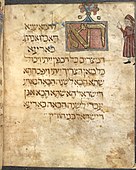- In the Sarajevo Haggadah, 1350 CE
- In the 14th century Barcelona Haggadah
- In the Rothschild Haggadah, 1450 CE. Includes use of the alternate Ha K'Lachma Anya.
- In the Sister Haggadah, 14th century.

Ha Lachma Anya ("This is the bread of poverty ("affliction")" is a declaration that is recited at the beginning of the Magid portion of the Passover Seder. Written in Aramaic, the recitation serves as the first explanation of the purpose of the Matzah during the Seder. [1]



